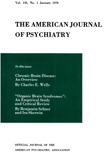THE PSYCHIATRIST AS AN ADVISOR AND THERAPIST FOR MEDICAL STUDENTS
Abstract
During the past 14 years approximately 25% of the entire student body at Cornell University Medical College has requested the assistance of a psychiatrist as an advisor or therapist. Any other group of individuals under similar stress at the same life period, and with the same degree of psychiatric insight, would probably respond in a like manner. The greatest number of requests for psychiatric aid were self-initiated and were directed toward the instructors. When anxiety was mobilized by the teaching of psychiatry, the instructors were able to recognize early signs of psychopathology, and to deal with them either by introducing concepts of mental hygiene into lectures or by inviting personal interviews. The dual role of the psychiatrist as a teacher and therapist was generally found to be more of an asset than a handicap in the development of an optimal case-finding technique, and in the successful therapeutic management of student patients. There was relatively little resistance to psychiatric treatment and in most instances the students were eager to pursue a more thorough investigation of their complaints and problems than time permitted.
Of the total number (123) of students who consulted the writer, 48.8% were seen from 1 to 3 hours in an advisory capacity or for treatment of minor personality disorders; 51.2% were found to have marked emotional or personality disorders and were treated for periods of 5 to 50 hours. The complaints or disorders themselves were related to some extent to the source of referral and to the year in which the students matriculated. Those environmental factors regarded by the students as most dynamically significant in their adjustment to medical school were the extreme academic demands, the threat of failure, competition, the transition from undergraduate to graduate school, economic insecurity and dependency, and obstacles to sexual satisfaction and marriage.
Access content
To read the fulltext, please use one of the options below to sign in or purchase access.- Personal login
- Institutional Login
- Sign in via OpenAthens
- Register for access
-
Please login/register if you wish to pair your device and check access availability.
Not a subscriber?
PsychiatryOnline subscription options offer access to the DSM-5 library, books, journals, CME, and patient resources. This all-in-one virtual library provides psychiatrists and mental health professionals with key resources for diagnosis, treatment, research, and professional development.
Need more help? PsychiatryOnline Customer Service may be reached by emailing [email protected] or by calling 800-368-5777 (in the U.S.) or 703-907-7322 (outside the U.S.).



